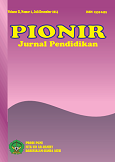UPAYA MENINGKATKAN HASIL BELAJAR SISWA PADA PELAJARAN FISIKA MATERI GERAK MELINGKAR MELALUI PENERAPAN MODEL PEMBELAJARAN KOOPERATIF TIPE STAD (STUDENT TEAMS ACHIEMENT DIVISION)
DOI:
https://doi.org/10.22373/pjp.v10i1.9313Keywords:
Learning Outcomes, Type STAD, Physics LessonsAbstract
The objectives of this study were (1) To determine the ability of teachers in implementing STAD type cooperative learning in Physics Lessons in class X-MIPA 1, (2) to increase student activity and (3) to improve student learning outcomes in class X-MIPA 1 SMAN 2 Banda Aceh on Physics Lessons in Circular Motion with the application of the STAD type cooperative learning model. The subjects of this study were students of class X-MIPA 1 with a total of 32 students. Data collection techniques in this study were through tests, observations, and questionnaires. Data collection tools used were observation sheets, test questions, and student response questionnaires. Data analysis was carried out by descriptive qualitative. Data processing is done in a way; (a) to see the activities of teachers and students through observation sheets, processed using descriptive statistics with an average score, (b) data on student learning outcomes is processed by looking at the level of individual and classical completeness, (c) the results of the data from the questionnaire are processed using simple percentage formula. The results showed that the teacher's ability to manage learning in the first cycle was declared almost good (3.56) then increased in cycle II with good criteria (4.42), while student activity in the first cycle was good enough (3.19) then the second cycle was good criterion (4.05). Thus the learning process has increased significantly so that it affects student learning outcomes which are quite good, namely student learning outcomes at the beginning of observation of student learning completeness only 53% of 32 students meaning students who did not complete learning as much as 47% , then after being given action with cooperative learning type STAD in the first cycle students who completed learning increased to 68.75%, who had not yet completed it decreased to 32.25% and in the second cycle students who completed learning increased to 81.25% and those who did not complete reduced to 18.75%.
References
Abdurrahman, Mulyono, 2003, Pendidikan Bagi Anak Berkesulitan Belajar, Jakarta: Rineka Cipta.
Arikunto, dkk.2009, Penelitian Tindakan Kelas, Jakarta: Bumi Aksara.
Djamarah, Syaiful Bahri, 2002, Psikologi Belajar, Jakarta: Rineka Cipta.
Dimyati dan Mudjiono, Belajar dan Pembelajaran, Jakarta: Rineka Cipta, cet. 3, 2006
E. Mulyasa. 2006. Implementasi Kurikulum 2004 Panduan Pembelajaran KBK, Bandung: Remaja Rosdakarya.
Hakim, Thursan. 2005. Belajar Secara Efektif. Jakarta: PuspaSwara.
Johar, Rahmahdkk. 2006. Strategi Belajar Mengajar. Banda Aceh: FKIP Unsyiah.
Margono. 2005, Metodologi Penelitian Pendidikan. Jakarta: Rineka Cipta.
Mardianto, 2012, Psikologi Pendidikan, Medan: Perdana Publishing
Muhammad Nur. 2003. Keterampilan Kooperatif. Jakarta: BumiAksara.
Nasution, S. 2004. Berbagai Pendekatan dalam Proses Belajar Mengajar, Ed. Revisi. Jakarta: Bina Aksara.
Purwanto Ngalim. 2002. Psikologi Pendidikan, Bandung: Remaja Rosda Karya.
Peraturan Menteri Pendidikan Nasional RI No 22 tahun 2006 tentang Standar Isi, Jakarta: Depdiknas.
Slameto. 2003. Belajar dan Faktor-Faktor yang Mempengaruhinya, Jakarta: Rineka Cipta.
Sudjana, Nana. 2005. Dasar-dasar IlmuPendidikan, Bandung: Tarsito.
Syah, Muhibbin. 2005. Psikologi Pendidikan, Jakarta: Raja Granfindo Persada.
Setya Nurachmandani, Fisika 2 untuk SMA/MA, Jakarta: Pusat Perbukuan, Departemen Pendidikan Nasional, 2009
Trianto, 2009, Mendesain Model PembelajaranInovatif-Progresif, konsep, landasan, dan Implementasinya padakurikulum K.13: Kencana Prenada Media Group.
Wiganda, Supria, 2007, Pengelolaan Kelas & Setting Kegiatan Belajar Mengajar. Jakarta: Mitra Solusi.
Yusuf, Munawir, dkk. 2003, Pendidikan Bagi Anak Dengan Problem Belajar.Solo: PT Tiga Serangkai Pustaka Mandiri.
Downloads
Published
Issue
Section
License
- Authors retain copyright and grant the journal right of first publication with the work simultaneously licensed under a Creative Commons Attribution License that allows others to share the work with an acknowledgment of the work's authorship and initial publication in this journal.
- Authors are able to enter into separate, additional contractual arrangements for the non-exclusive distribution of the journal's published version of the work (e.g., post it to an institutional repository or publish it in a book), with an acknowledgment of its initial publication in this journal.
- Authors are permitted and encouraged to post their work online (e.g., in institutional repositories or on their website) prior to and during the submission process, as it can lead to productive exchanges, as well as earlier and greater citation of published work (See The Effect of Open Access).

